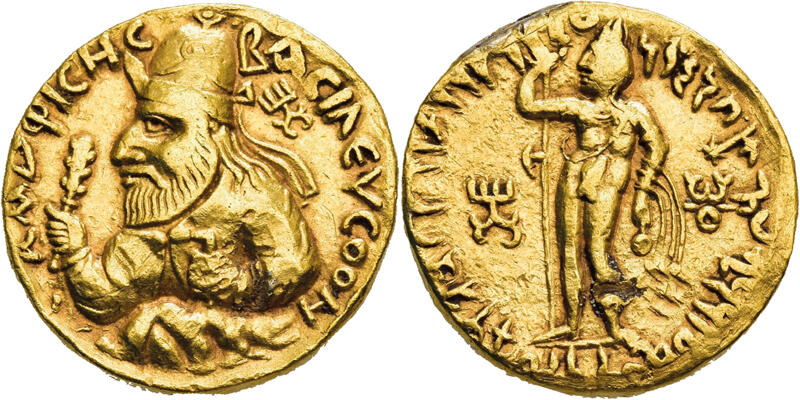S 1656 - Begram ? (Vima Kadphises), gold, dinars (113-128 CE)
From SILVER
113 CE - 128 CE Gold 33,306 kg
Description
| ObverseInscription or printing placed on the obverse.: | (Greek).Bearded bust of king left wearing tall cap, emerging from mountain top represented as round boulders, holding club in right hand and with left hand on hilt of sword |
| ReverseInscription or printing placed on the reverse.: | (Karosthi).Oesho/Shiva standing facing, head left, holding trident in right hand, water-pot and animal skin in left |
Mint and issuing power
| MintIdentifies the place of manufacture or issue of a numismatic object.: | Begram | Ancient regionAncient region.: | Bactria | Modern countryModern country: Afghanistan | AuthorityIdentifies the issuing power. The authority can be "pretended" when the name or the portrait of X is on the coin but he/she was not the issuing power. It can also be "uncertain" when there is no mention of X on the coin but he/she was the issuing power according to the historical sources: | Vima Kadphises |
Chronology
| FromIdentifies the initial date in a range assigned in a numismatic context. | 113 CE | toIdentifies the final date in a range assigned in a numismatic context.. | 128 CE | PeriodTime period of the numismatic object.: Roman from 30 BC |
Physical description
| MetalThe physical material (usually metal) from which an object is made.: | Gold |
Median weightMedian of the weights of numismatic objects (in grams). in grams | 7.90 | DenominationTerm indicating the value of a numismatic object. Examples: tetradrachm, chalkous, denarius.: | dinar, stater |
StandardStandard.: |
Image

S1656 Vima Kadphises staters.jpg [1]
References
| Die study referencePublication of the study: | Bracey 20091Bracey 2009 | ||
| Coin series referenceReference to coin series study: | |||
Obverse dies distribution
no distribution is available
Reverse dies distribution
no distribution is available
Quantification
| Number of obversesNumber of obverse dies. ᵖ (o) | 20 | Number of singletons (o1)The number of singleton coins. ᵖ | |
| Number of reverse diesNumber of reverse dies. (r) | 56 | Number of coinsNumber of coins. (n) | 140 |
| Coins per obverse dieNumber of coins per obverse die. (n/o) | 7 | Coins per reverse dieNumber of coins per reverse die. (n/r) | 2.5 |
| Reverse per obverse ratioRatio of obverse dies divided by reverse dies. (r/o) | 2.8 | Percentage of singletons (o1)number of coins (n) divided by the number of singletons (o1) ᵖ | % |
| Original number of dies (O) (Carter 1983 formula)The estimation of the number of coins according to Carter 1983 ᵖ | 21.08 | Coins struck if 20,000 as average productivity per dieCoins made if the average productivity for obverses (according to Carter) is 20,000. ᵖ | 421,600 |
| Original number of dies (O) (Esty 2011 formula)The estimation of the number of coins according to the singleton formula in Esty 2011 ᵖ (O) | 23.33 | Survival rate if 20,000 as average productivity per dieSurvival rate if average productivity is 20,000. ᵖ | 0.00033 |
| Coverage (o = % of O) (Esty 1984 formula)Esty 1984 - coverage (% of O) ᵖ (o = % of O) | % | Die productivity if survival rate 1/2,000Average productivity if survival rate is 1/2,000. ᵖ | 13,282.73 |
| Weight of silver (in kg) if 20,000 coins per die (O = Carter formula)Carter 1983 * Median weight * 20000 (*10 if gold or electrum) ᵖ | 33,306 kg <br /> 33,306 kg | Die productivity if survival rate 1/5,000Average productivity if survival rate is 1/5,000. ᵖ | 33,206.83 |
Remarks
Most likely more than 2 workstations
References
- ^ Bracey, Robert (2009), The Coinage of Wima Kadphises, Gandharan Studies, 3, p. 25-75.